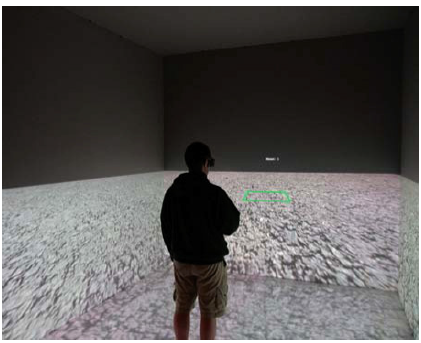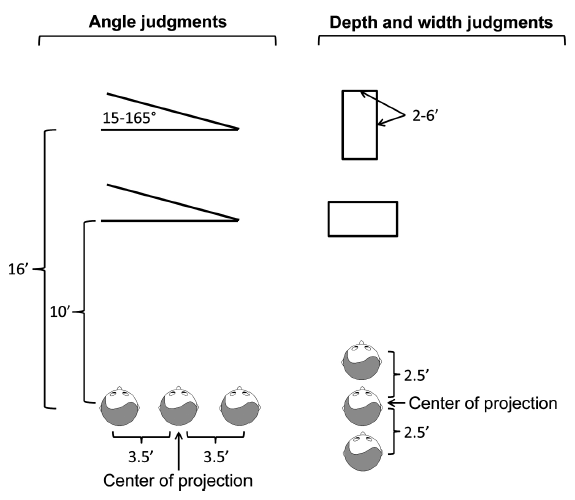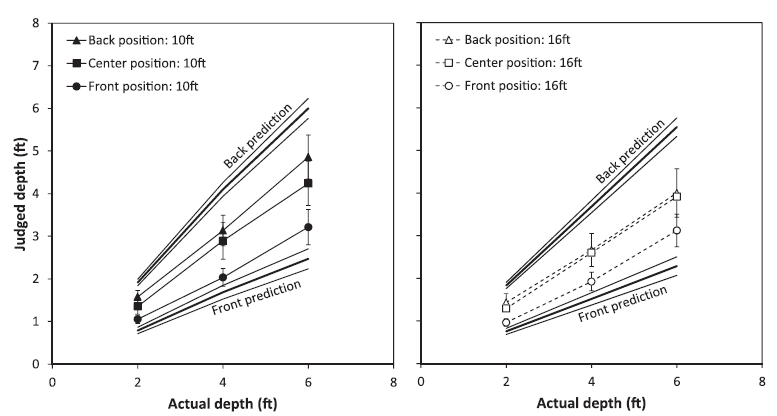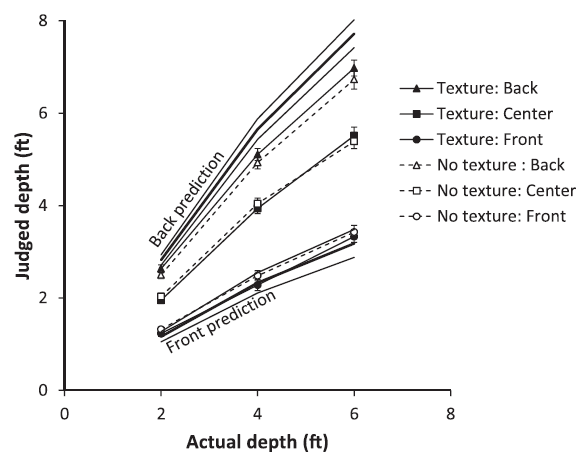ABSTRACT
Virtual reality systems commonly include both monocular and binocular depth cues, which have the potential to provide viewers with a realistic impression of spatial properties of the virtual environment. However, when multiple viewers share the same display, only one viewer typically receives the projectively correct images. All other viewers experience the same images despite displacement from the center of projection (CoP).
Three experiments evaluated perceptual distortions caused by displacement from the CoP and compared those percepts to predictions of models based on monocular and binocular viewing geometry. Leftward and rightward displacement from the CoP caused virtual angles on the ground plane to be judged as larger and smaller, respectively, compared to judgments from the CoP.
Backward and forward displacement caused rectangles on the ground plane to be judged as larger and smaller in depth, respectively, compared to judgments from the CoP. Judgment biases were in the same direction as cue-based model predictions but of smaller magnitude. Displacement from the CoP had asymmetric effects on perceptual judgments, unlike model predictions. Perceptual distortion occurred with monocular cues alone but was exaggerated when binocular cues were added. The results are grounded in terms of practical implications for multiuser virtual environments.
EXPERIMENT 1

Fig. 2. A participant stands in the C6 viewing the virtual environment used in Experiment 1. The virtual green rectangle in front of the participant is one of the stimuli used to evaluate perceived depth and width.
The experiment was conducted within the C6 (Figure 2), a virtual reality system with a six-sided cubic configuration of projection screens measuring 10 × 10 × 10 ft (3.05 × 3.05 × 3.05 m). The virtual environment was created using Open Scene Graph and VR Juggler [Cruz-Neira et al. 2002], a commonly used application programming interface for clustered graphics applications. Each screen of the C6 was back-projected with 4,000 × 4,000 pixel stereo resolution and updated at 60Hz (30Hz per eye in stereo).

Fig. 3. Stimuli used in the experiments. The left panel shows the shapes and viewing locations used for angle judgments. The right panel shows shapes and viewing positions used for depth and width judgments.
Participants made angle judgments while standing at the CoP or after displacement by 3.5ft (1.07m) leftward or rightward from the CoP (see Figure 3, left panel). Participants made depth and width judgments while standing at the CoP or after displacement by 2.5ft (0.76m) forward or backward from the CoP (see Figure 3, right panel).

Fig. 6. Depth judgments in Experiment 1 shown as a function of actual object depth, participant viewing location, and egocentric distance to the object (Left panel).
Fig. 6. Depth judgments in Experiment 1 shown as a function of actual object depth, participant viewing location, and egocentric distance to the object (Left panel: 10ft distance; Right panel: 16ft distance). Error bars indicate ±1 standard error. Model predictions after forward and backward displacement are also depicted (thick lines indicate predictions calculated from the intended viewing positions; thin lines indicate predictions calculated from viewing positions ±4in away from the intended viewing positions).
EXPERIMENT 2

Fig. 8. Depth judgments in Experiment 2 shown as a function of actual object depth, participant viewing location, and texture condition.
Fig. 8. Depth judgments in Experiment 2 shown as a function of actual object depth, participant viewing location, and texture condition. Error bars indicate ±1 standard error. Model predictions after forward and backward displacement are also depicted (thick lines indicate predictions calculated from the intended viewing positions; thin lines indicate predictions calculated from viewing positions ±4in away from the intended viewing positions).
EXPERIMENT 3

Fig. 9. Depth judgments in Experiment 3 shown as a function of actual object depth, participant viewing location, and texture condition.
Fig. 9. Depth judgments in Experiment 3 shown as a function of actual object depth, participant viewing location, and texture condition. Error bars indicate ±1 standard error. Model predictions after forward and backward displacement are also depicted (thick lines indicate predictions calculated from the intended viewing positions; thin lines indicate predictions calculated from viewing positions ± 4 in away from the intended viewing positions).
GENERAL DISCUSSION
The current project was designed to evaluate the perceptual distortion caused by displacement from the CoP, and to compare those distorted percepts to model predictions based on distortions in perspective and stereo viewing geometry (model identical predictions under the conditions tested in these experiments). In Experiment 1, leftward and rightward displacement of the viewing position relative to the CoP caused leftward-opening angles on the ground plane to be judged as larger and smaller, respectively, compared to judgments made from the CoP. Backward and forward displacement from the CoP caused rectangles on the ground plane to be judged as larger and smaller in depth compared to judgments made from the CoP.
Although distortions of perceived angle and depth after displacement were biased in the directions predicted by the cue-based models, the magnitude of judgment biases was significantly less than model predictions. Experiment 2 was conducted to evaluate whether the smaller-than-expected biases were the result of monocular depth cues, which participants might have used to partially correct for the distorted stereoscopic depth cues. To that end, the second experiment tested the effect of forward and backward displacement on depth judgments in a virtual environment with and without a textured ground plane. It was expected that removal of the ground texture would result in errors that were more consistent with the model predictions.
Contrary to the hypothesis, judgments were closer to veritical when the texture was absent than when the texture was present, a finding that may be attributable to the specific distance tendency (see Experiment 2 Discussion section). Experiment 3 evaluated the relative contributions of monocular and binocular depth cues by comparing depth judgments made after displacement from the CoP when the scene contained only monocular depth cues or both monocular and binocular depth cues. Depth judgments were biased in the direction predicted by the cue-based models, but the magnitude of the bias was greater when the scene contained both monocular and binocular depth cues than when it contained monocular cues alone.s based on perspective and stereo geometry made nearly.
Source: Iowa State University
Authors: Jonathan W. Kelly | Melissa Burton | Brice Pollock | Eduardo Rubio | Michael Curtis | Julio de la Cruz | Stephen B. Gilbert | Eliot H. Winer